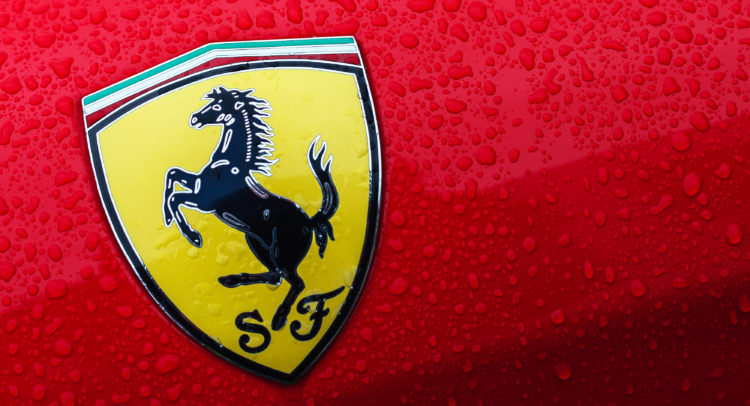Italy-based Ferrari NV (RACE) designs, manufactures, and sells luxury performance sports cars. The company offers sports, GT, special series cars, limited-edition hypercars, and more.
It also provides non-registered racing cars; and spare parts and engines, as well as after-sales, repair, maintenance, and restoration services for cars.
Although the company has very strong fundamentals, we are neutral on the stock.
Measuring Ferrari’s Efficiency
Ferrari holds inventory to keep its business running. Therefore, the speed at which a company can move inventory and convert it into cash is very important in predicting its success. To measure its efficiency, we will use the cash conversion cycle, which shows how many days it takes to convert inventory into cash. It is calculated as follows:
CCC = Days Inventory Outstanding + Days Sales Outstanding – Days Payables Outstanding
Ferrari’s cash conversion cycle is -13, meaning the company converts inventory into cash before having to pay suppliers. Basically, Ferrari doesn’t have to put up any money to finance inventory purchases because it can move its inventory and collect the payments while still on credit. Thus, Ferrari’s suppliers are essentially financing its operations.
In addition to the cash conversion cycle, let’s also consider Ferrari’s gross margin trend. Ideally, it is good to see a company’s margin expand each year. If its gross margin is already very high, it is acceptable for it to remain flat.
In Ferrari’s case, its gross margin increased in the past decade, from 46.1% in 2012 to 50.8% in the last 12 months. Although the gross profit margin has decreased slightly over the past several years from its peak of 52.6%, it doesn’t seem like something to be concerned about.
This is because its margin has remained very steady over the past decade, which is impressive considering that the automotive industry is very cyclical. As a result, the gross margins of most automakers fluctuate with the business cycle. The fact that Ferrari is shielded from this cyclicality demonstrates the competitive advantage it enjoys as a strong luxury brand.
This relatively stable growth in its gross margin is ideal because it allows the company the opportunity to increase free cash flow or reinvest a larger percentage of revenue into growth initiatives.
DuPont Analysis – High Earnings Quality
When taking a look at Ferrari’s return on equity, we can see that the trend has been flat. Stocks with a high return on equity tend to outperform the market, which is why it is an important metric to watch.
The company’s return on equity trend is as follows:

Ferrari has a volatile trend that appears to be decreasing. However, let’s take a deeper look at why the trend is so volatile and why it has been decreasing. When breaking down the ROE trend into a DuPont analysis, we can separate it into three different parts.
The first part is the profit margin, which measures what percentage of revenue the company keeps as profit. The second part is asset turnover, which measures how efficiently a company uses its assets to generate revenue. Lastly, we arrive at the equity multiplier to measure how much leverage the company uses.
By multiplying all three metrics together, we arrive at ROE. The DuPont analysis is useful because it helps management and investors determine the key drivers of return on equity. It also allows managers to address issues such as too much leverage or inefficient uses of assets.
For Ferrari, the breakdown of ROE is as follows:

Now that we have a clearer picture, we can see that the two most important metrics, profit margin and asset turnover, have actually been quite stable in the past few years. The main driver of the ROE volatility and decline has actually been the company’s change in leverage, which has decreased substantially.
As a result, although the ROE has declined, the DuPont analysis suggests that Ferrari’s earnings quality has improved because of the reduced leverage. Therefore, with a current ROE of 40%, we can confidently say the company is very effective at generating returns.
Risks
To measure Ferrari’s risk, we will first check if financial leverage is an issue. We do this by looking at its debt-to-free-cash-flow ratio. Currently, this number stands at 2.43.
Overall, we don’t believe that debt is currently a material risk for the company because its interest coverage ratio is 24.3 (calculated as free cash flow divided by interest expense). This means that Ferrari can pay its annual interest expenses 24.3 times over using its operating income.
However, there are other risks associated with the company. According to Tipranks’ Risk Analysis, Ferrari has disclosed 58 risks in its most recent earnings report. The highest amount of risk came from the Finance & Corporate category.
Wall Street’s Take
Turning to Wall Street, Ferrari has a Moderate Buy consensus rating based on five Buys, one Hold, and one Sell assigned in the past three months. The average Ferrari price target of $248.87 implies 31.5% upside potential.

Final Thoughts
Ferrari is definitely one of the strongest brands in the world with very stable fundamentals, something that is uncommon in the automotive industry. The company is likely to be more resilient than most due to its target market, which is made up of very wealthy individuals who aren’t as impacted by rising inflation costs.
Nevertheless, if the Federal Reserve continues being aggressive for an extended period of time, the overall stock and real estate markets may continue to fall. Given that wealthy individuals tend to have large stock and real estate portfolios, they might cut back on luxury purchases if the sell-off persists for too long.
As a result, we remain neutral on the stock.
Discover new investment ideas with data you can trust.
Read full Disclaimer & Disclosure









